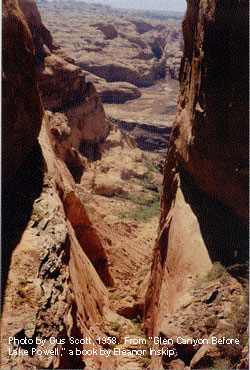 |
|

Although the Glen Canyon Dam has provided numerous benefits for the surrounding area over the years, it is inevitable that there are some costs associated with it. Whereas at the time of the building of the Glen Canyon Dam ecological costs were not considered of great importance, it would be wrong (presently) to not account for these substantial but frequently unquantifiable costs. It is useful to divide the costs into categories according to who the costs are borne by. The first group of costs associated with the Glen Canyon would be the economic costs. That is to say, any costs that would appear in a typical cost-benefit analysis. The second group of costs would be the ecological costs which although not directly economic, they do have a significant impact on the economy in the long run. As Robert Costanza explains, "Because ecosystem services are not fully ‘captured' in commercial markets or adequately quantified in terms comparable with the economic services and manufactured capital, they are often given too little weight." (Costanza, 253)
The total cost of the Glen Canyon Dam in terms of dollars and cents, including the dam, power plant, bridge, access roads and facilities, is estimated at $272 million dollars according to 1963 dollars. The maximum power generation of the Glen Canyon Dam is 1300 megawatts with full reservoir conditions. However, after being built for this capacity it was discovered that operating at full capacity seriously damages the downstream riparian environment. Because of this, the Bureau of Reclamation restricts the water flow so that the total generation of electricity is between 500 and 800 megawatts. The majority of the debt that the Glen Canyon Project developed is being repaid to the United States Treasury through the sale of electricity. However, the rate at which they are able to pay the Treasury is slowed because of the Bureau of Reclamation's limit on the power generation. (http://www.glencanyon.org)
The most substantial quantifiable costs associated with the Glen Canyon Dam are the year to year costs. These costs include, auxiliary facilities, maintenance, both of which are payed by the Bureau of Reclamation on a year to year basis. David Wegner of the Glen Canyon Institute estimates that annual maintenance costs are between 5 and 7 million dollars excluding costs for the maintenance of the power generators. The power generator's maintenance is more variable ranging anywhere between 5 and 20 million dollars per annum. Furthermore, other year to year costs include paying the 35 employees that work on the Bonneville site. This cost amounts to approximately 1-2 million a year. Therefore, the total year to year costs range between 11 and 29 million dollars. (David Wegner, personal contact)
The construction of the Glen Canyon Dam has perhaps incurred more ecological costs than any other costs. The millions of pounds of silt that once flowed and settled along the Colorado River streambed are now contained to Lake Powell reservoir. The result of the reduction of silt in the water has been of great importance socio-culturally for the people and the animals that have had to learn to live with the consequences. Not only is the river eroding the riparian zones at an alarming rate, but it is no longer depositing new silt to naturally reinforce the riparian zones. In addition, the reduction in siltation has reduced the water temperature to a point at which the number of fisheries present in the Colorado River has diminished. This has had a tremendous effect for the fishermen of the region. (Palmer, 1994) To find out more about the Glen Canyon Dam and its effects on the ecology of the area, link to the ecology section .
Another cost of the Glen Canyon Dam could have been avoided. In the mid 1980's the Bureau of Reclamation rewound the turbines to achieve higher outputs. Their reasoning was to provide more power when the people of the Southwest were more willing to pay higher prices (air-conditioning on the hot summer days). The result has been a significant ecological cost for the area. In order to provide more power, the Glen Canyon Dam released relatively large amounts of water for a few hours in the afternoons. The sporadic dam releases not only had a deleterious effect on the riparian zones, but they also effected recreation. At the time their were reports of boats being stranded atop of rocks that surfaced with the reduction in flow.(Palmer, 1994)
Another evident cost of the Glen Canyon Dam is evaporation of Lake Powell. The loss of 1.5 million acre feet per year due to evaporation on Lake Powell is costly in the sense that it is not maximizing the use of the water once it is in the reservoir.
A final cost of the Glen Canyon dam that is important to note is that before dammed, the Colorado river delivered water to Mexico presenting a possible profitable economic resource for the Mexican government. However, the United States has effectively harnessed all of the water in the Colorado river thereby denying Mexico of any economic opportunity that the water might produce.
 |
|